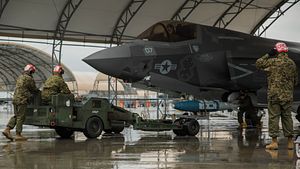U.S. Marine Corps Fighter Attack Squadron 121, the service’s first overseas-deployed F-35B squadron, has conducted a hot-reload exercise at an airbase in Iwakuni in Yamaguchi Prefecture on April 6.
It was the first time that ordnance was loaded onto a running F-35B, the U.S. Marine Corps variant of the supersonic fifth-generation F-35B Lightning II Joint Strike Fighter, capable of vertical or short takeoffs and vertical landings without requiring a catapult launcher.
The exercise was conducted while the pilot remained in the cockpit with the aircraft’s engine running. The drill is meant to train the ground crew to reload the aircraft as fast possible during sorties. Based on a video posted about the exercise, the weapon loaded onto the F-35B appears to be a 1,000-pound GBU-32 Joint Direct Attack Munition (JDAM), a guidance kit that converts unguided bombs into all-weather precision-guided munition.
The press release notes that the training is necessary in order to “prepare for real-world scenarios” and “vital to improving as a squadron and continuing to move forward toward being ready when called upon to fight.” With tensions in East Asia heating up, these real-world scenarios could include missions over the Korean Peninsula, Taiwan and the South China Sea.
The F-35B was developed to replace the Marine Corps’ F/A-18 Hornet, AV-8B Harrier and EA- 6B Prowler aircraft. The fifth-generation aircraft’s mission radius is greater than that of the F/A-18 Hornet and AV-8B Harrier II. “The unique combination of stealth, cutting-edge radar and sensor technology, and electronic warfare systems bring all of the access and lethality capabilities of a fifth-generation fighter, a modern bomber, and an adverse-weather, all-threat environment air support platform,” the U.S. Marine Corps noted in a January 12 statement.
As I explained elsewhere:
The U.S. Navy will deploy one of its largest surface warships, the Wasp-class amphibious assault ship USS Wasp, to Japan in the fall of 2017. The ship will be able to operate the F-35B from its flight deck. In November and December 2016, the U.S. Navy conducted a number of operational tests of the F-35B aboard an America-class amphibious assault ship in preparation for the deployment of the warship to the Asia-Pacific region (See: “F-35B Completes Weapons Load Testing on US Navy Amphibious Assault Ship”).
In addition, I noted:
Tokyo will also soon operate its own fleet of F-35As. The first foreign military sales (FMS) F-35A fighter jet was handed over to Japan in late November. The Japan Air Self Defense Force (JASDF) will receive 42 F-35As in the coming years. Furthermore, the JASDF is set to procure up to 100 additional new fifth-generation air superiority fighter aircraft by the 2030s.
Fighter Attack Squadron 121 currently consists of ten aircraft with six more F-35Bs to arrive in June of this year. According to the U.S. Marine Corps press statement, the squadron will continue training and increase its operational readiness in the coming months.

































